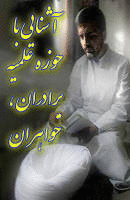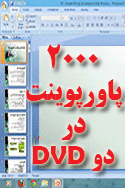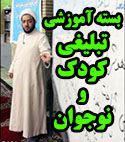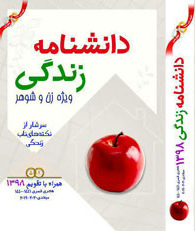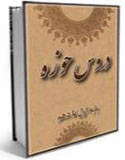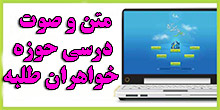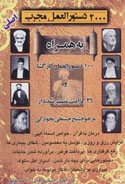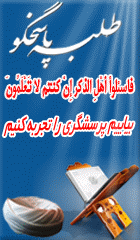کلیپ های دیدنی
مشاوره و خانواده
با توجه به ترک خود ارضایی عوارض آن هنوز در من هست چگونه آن را برطرف کنم ؟
13-08-1399 بازدید:5225 مباحث جنسی و زناشویی همکار پاسخگو

آیا بخاطر وسواس فکری توهین به مقدسات گناه دارد؟
19-05-1398 بازدید:4814 مشکلات و اختلالات روانی همکار پاسخگو
آیا از طریق اینترنت می تواند ازدواج موقت کرد ؟
پرسش: با سلام من 22 سالمه از پارسال با يه دختري در…
از زندگی سیر شدم و آرامش ندارم چکار کنم؟
پرسش : سلام..خواهش ميکنم يه راهي جلو روم بذارين من از…
من از تاریکی شب به دلیل توهمات ذهنیم میترسم چکار کنم؟
پرسش: من وقتي در خانه تنها مي شوم و هوا تاريك…
شب ها كابوس فيلم هاي مبتذل را که قبلا نگاه می کردم میبینم!
پرسش: (در خصوص توبه از ديدن فيلم هاي مبتذل) در اين…
بنده متاهلم و در اینترنت با دختری آشنا شدم که کارمون به گناه کشید!
پرسش: بنده یک مشکلی دارم که می خواستم از شما راهنمایی بخواهم…
جوانی هستم که از زندگی خسته شده و احساس پوچی می کنم!
پرسش: راستش نمی دانم از کجا شروع کنم. 20 ساله هستم…
از طریق اینترنت با پسری آشنا شدم و مدتها با هم در ارتباط بودیم!
پرسش:من دانشجوی ارشد رشته حقوق تقریبا حدود 1 سال پیش…
چرا خانواده ها عاشق شدن را برای جوانان (دختر) بد می دانند؟
پرسش: چرا خانواده ها عاشق شدن را برای جوانان (دختر) بد…
چگونه دیدن فیلم های مبتذل را ترک کنم؟
پرسش: با سلام به حضور حضرت عالي اگرخاطرتان باشد ،من قبلا هم…
با شوهرم قبل از ازدواج رابطه نانشروع داشتم!
پرسش: با سلام من زنی 25 ساله هستم.حدود 1 سال است…
اگر دختری عاشق غیر هم جنس خود...؟
پرسش: اگر دختری عاشق غیر هم جنس خود شود البته نه…
اگر نتوانيم جلو شهوت خود را بگيريم ، چه بايد بكنيم ؟
پرسش: اگر نتوانيم جلو شهوت خود را بگيريم ، چه بايد…
جوانی هستم 21 ساله اهل تهران و تمایل زیادی به سکس دارم
پرسش: من جوانی هستم21 ساله اهل تهران وتمایل زیادی به سکس…
نمي دونم چرا از ازدواج مي ترسم؟!
پرسش: سلام مشکل من اینه که نمي دونم چرا از ازدواج مي…
چرا به زن مطلقه با یک چشم و دید دیگری نگاه می کنند؟!!
پرسش: سلام حاج آقا من یک خانم مطلقه هستم و سوالم اینه…
چرا مخالف رابطه دختر و پسر هستید؟؟!!
پرسش: سلام حاجاقا چند تا سوال داشتم ممنون میشم جواب بدید. 1 چرا…
شب زفاف یا حجله چه شبی است و زن و مرد چکار باید بکنند؟
پرسش: شب زفاف و یا شب حجله که در روایات هم…
چه زمانی برای رابطه جنسی با همسر مناسب است؟
پرسش: چه زمانی برای رابطه جنسی با همسر مناسب است؟ و…
دختری که در سن جوانی و نوجوانی دچار شهوت می شود چه باید بکند؟
پرسش:دختری که درسن جوانی و نوجوانی دچار شهوت می شود…
می خواهم خوب باشم ولی دوست دخترم نمی گذارد!!
پرسش: به دلیل که من مدتی است به شهر آمده ام…
وقتی که عصبانی می شوم دیگر هیچ چیزی دست خودم نیست چکار کنم؟
پرسش: سلام آقای پاسخگو من دارای اخلاق بدی هستم وبا همه خواهر…
من دحتر قبلی نيستم و به يك دختر فاسد تبديل شده ام!
پرسش: من دختري هستم 14ساله من اول دختري سنگين بودم اما…
در مورد وسواسی و راه درمان آن توضیح بفرمایید؟
پرسش: وسواسی چیست و برای درمان آن چه راهکارهایی معرفی می…
خواسگارم بد اخلاق است آیا جواب مثبت بدهم؟
سوال: آیا به پسر بد اخلاق که خواستگاری کرده جواب مثبت…
اخلاقم رُك گفتن است اما حق ميگويم و شوهرم مخالف رفتارم است.
پرسش: اخلاقم رُك گفتن است اما حق ميگويم و شوهرم…
خواستگارم دو ازدواج و یک نامزدی ناموفق داشته جواب مثبت بدم؟
پرسش: خانمی هستم که در گذشته، یک ازدواج_ناموفق داشتم. در حال…
شوهرم گلایه میکنه که چرا همیشه به حرفم گوش میدی!
پرسش: من 20 سالمه 1 ساله ازدواج کردم شوهرم 22 سالشه…
دختر 36 ساله ای که چهره زیبایی ندارد چکار کند؟
پرسش: با سلامدختر 36 ساله اي که مومن و حافظ قرآن…
اختلاف سني پسر با دختر تا چه مقدار ايده آل است؟
پرسش: ميخواستم بدونم ايا ازدواج با دختري که سنش با پسر…
چگونه از انحرافات جنسى به دور باشيم؟
پرسش: در فاصله سنّ بلوغ تا هنگام ازدواج چگونه از انحرافات…
بعضی وقتا اعصابم میریزه بهم با نامزدم بدرفتار میکنم چطورخودمو کنترل کنم؟
پرسش: سلام ببخشید ی سوالی داششتم من دختری۱۸سالم ۷ماهه عقدکردم بعضی…
نقش خانواده در تربيت فرزندان چیست؟
پرسش: نقش خانواده در تربيت فرزندان چیست؟ پاسخ: با سلام و ادب خدمت شما…
نامزدم مي خواهد در كوچه و خيابان آرايش كرده و كمي از موهايم را از روسري بيرون بگذارم!
پرسش: من تا قبل از نامزديم بسيار با حجاب بودم. البته…
چرا برخی مردان در کنار همسرشان آرامش نمی یابند؟
پرسش: قرآن مجيد وجود زن را كانون محبّت و…
علت و شرايط تحقق صيغه چيست؟
پرسش: علت و شرايط تحقق صيغه چيست؟ پاسخ:…
چرا بین دو هوو همیشه اختلاف وجود دارد؟
پرسش: چرا بين دو همسر(زن) با وجود مشروعيّت ازدواج…
پرسش و پاسخ
آیا کسی که شراب بنوشد تا چهل روز نماز و عباداتش قابل قبول نیست ؟
13-08-1399 بازدید:2600 مسائل متفرقه نماز همکار پاسخگو

اذان در جامعه اسلامی نماد چیست ؟ و چرا فقط سه بار در روز تکرار می شود ؟
پرسش: اذان در جامعة اسلامی نماد چیست و…
حکم مشروبات الکلی از دیدگاه اسلام چیست ؟
پرسش: حکم مشروبات الکلی از دیدگاه اسلام چیست…
چرا با این همه ظلم و ستم در جهان امام زمان (عج) ظهور نمی کند ؟
پرسش: چرا با این همه ظلم و ستم…
اگر نگاه به نامحرم گناه است چرا در فیلمهای خارجی زنهای بدون حجاب را نشان میدهند؟
پرسش: چرا میگویند نگاه کردن به نامحرم گناه…

با چه شیوه هایی میتوانیم پیرو انبیاءالهی باشیم ؟
پرسش : چه راه و روشی را پیبگیریم…
چرا زرتشتیان به اعتقاداتشان پایبند هستند ولی مسلمانان نه؟
پرسش : چرا در دین زرتشت گفتار نیک،…
چرا معانی دقیق آیات قرآن مشخص نیست و نیاز به تفسیر دارد ؟
پرسش : به چه دلیل تا تفسیرهای متعدد…
آیا جهت انجام هر کار نامشروعی می توان صیغه جاری کرد ؟
پرسش : اهمیت صیغه کردن در چیست؟ با…
اگر پیامبر (ص) عرب زبان نبود آیا قرآن باز هم به زبان عربی نازل می شد؟
پرسش : اگر حضرت محمد(ص) زبان دیگری به…
آیا در بین پیامبران ،پیامبر خشن هم وجود دارد؟
پرسش : پیامبران به مهربانی معروف میباشند آیا…
با توجه به محاسن روزه آیا معایبی هم در آن هست ؟
پرسش : روزه محاسن بسیاری دارد، آیا این…
جنس خداوند از چه چیزی می باشد و خدا چیست؟
پرسش : جنس خداوند از چه چیزی میباشد…
معنی خدا چیست؟چرا خداوند از حروف دیگر استفاده نکرده است؟
پرسش : تعریف لغوی خدا چیست و چرا…
خال کوبی ابرو (تاتو )از نظر شرعی برای وضو و غسل چه حگمی دارد ؟
پرسش : خالکوبی ابرو (تاتو) از نظر شرعی…
شنیدن صدای زنان در مراسم عزاداری و مولودی چه حکمی دارد ؟
پرسش : شنیدن صدای زنان در مراسم عزاداری…
در چه صورتی امر به معروف و نهی از منکر واجب می شود؟
پرسش : در چه صورتی امر به معروف…
چرا در ایران مردی که از دین خود برگردد حکم اعدام را دارد ؟
پرسش: چرا در ایران مردی که از دین…
آیا ازدواج زن شیعه با مرد سنی اشکال دارد؟
پرسش : آیا ازدواج زن شیعه با مرد…
لمس آیات قرآنی که بر سنگ قبر نوشته شده است بدون وضو چه حکمی دارد ؟
برسش : لمس آیات قرآنی که بر سنگ…
فرق بین احتیاط واجب و احتیاط مستحب چیست؟
پرسش : فرق بین احتیاط واجب و احتیاط…

آیا با زیارت امامان و بوسیدن ضریح آنان انسان دچار شرک می شود؟
پرسش : آیا اعتقاد به این که شیعیان…

چرا در نماز از مهر استفاده میکنیم و فقط پیشانی بر خاک قرار می دهیم؟
پرسش : با توجه به این که هنگام…
آیا علائم هنگام ظهور امام زمان (عج) واقعیت دارد؟
پرسش : آیا وجود نشانههایی هنگام ظهور حضرت…
با وجود مساوات بین زن و مرد چرا مردان در اولویت قرار دارند؟
پرسش : با توجه به این که ما…
طریقه خواندن نماز در زمان رسول خدا (ص) چگونه بوده است؟
پرسش : طریقه نماز خواندن از زمان رسول…
چگونه می توانیم از گناه غیبت پرهیز کنیم؟
پرسش : چگونه میتوانیم از گناه غیبت پرهیز…
چگونه از بدخلقی و صفات زشتم دوری کنم؟
پرسش : چه راهی وجود دارد که انسان…
قطع رابطه با اعضای خانواده که از نظر شخصیتی و اجتماعی مشکل دارند گناه است؟
پرسش : آیا قطع رابطه با افراد خانواده…
آیا روح انسان بعد از مرگ در جسم دیگری دمیده می شود و دوباره به زندگی میکند؟
پرسش : آیا این نظریه درست است که…
اینکه در نماز کاهلی میکنم آیا در دینم خللی ایجاد می شود؟
پرسش : خدا را خیلی دوست دارم،همیشه در…
دلیل علاقه خاص به بعضی از امامان چیست؟
پرسش : چرا برخی برای بعضی امامان ارادات…
در شب اول قبر چه سوالاتی از ما پرسیده می شود ؟
پرسش : شب اوّل قبر چه سئوالاتی از…
آیا دوست داشتن یک نا محرم و ارتباط با او گناه است؟
پرسش : اگر کسی را واقعاً از صمیم قلب…
آیا ادعای ملاقات امام زمان (عج) از جانب برخی افراد صحت دارد ؟
پرسش : بر اساس روایتهای فراوانی امام زمان(عج)…
چرا به اصول و قواعد دین اسلام توجه نمی شود و پذیرش آن از سوی پیروان ادیان دیگر سخت است…
پرسش : دین اسلام کاملترین دینهاست و آسانترین…
آیا نظریه تناسخ از دیدگاه اسلام پذیرفته شده است ؟
پرسش : آیا نظریه تناسخ که بزرگان زیادی…
دست نوشته های طلبه پاسخگو
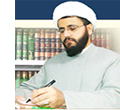
برای احترام به این ماه هم که شده این کار را انجام بده. مطمئن باش که یاد خدا باعث می شود که هیچوقت به سمت آن اشتباهات نروی.
برای همین یک ماه هم که شده از آن ها صرف نظر کرد و در ضیافت خدا شرکت بنما. بعد از این یک ماه، کیفیت زندگی ات را با گذشته مقایسه کن.
اگر بدتر شده بودی، دوباره به سمت آن گناهان و اشتباهات برو. ولی این ماه چنان عشقی به تو می دهد که دیگر زندگی ات به مانند گذشته نخواهد شد. این ماه خداوند تو را با عشق پذیرایی می کند.
Why do the Shī‘ah prostrate on turbah (dried clay)?
Question
Why do the Shī‘ah prostrate on turbah (dried clay)?
Answer
Some think that prostration on the earth or turbah taken from the burial site of martyrs is tantamount to worshipping it and consider it a form of polytheism (shir).
In reply to this question, it must be noted that there is a great difference between the phrase, “as-sujūd lillāh” (prostration for Allah), and “as-sujūd ‘ala’l-arḍ” (prostration on earth). The problem of the mentioned people is that they fail to distinguish between the meanings of the two phrases.
It is clear that the meaning of “as-sujūd lillāh” is “prostration for the sake of Allah” while “as-sujūd ‘ala’l-arḍ” means “prostration on the earth”. In other words, by prostrating on earth we prostrate for the sake of God, and in principle, all Muslims of the world prostrate on something for the sake of God. All pilgrims to the House of God prostrate on the stones of Masjid al-Ḥarām in the same way but their aim is prostrating for the sake of God.
Given this, it becomes clear that prostration on earth, plant byproduct, etc. does not mean worshipping them but it means prostrating for the sake of God and worshipping Him by lowering oneself and getting close to earth. Similarly, it becomes clear that prostration on turbah is different from prostration for turbah.
On one hand, the Holy Qur’an states:
﴿وَللهِ يَسْجُدُ مَن فِي السَّمَوَاتِ وَالأرْضِ ﴾
“To Allah prostrates whoever there is in the heavens and the earth.”[1]
Also, the Holy Prophet (ṣ) says:
”جُعِلَتْ لِيَ الأَرْضُ مَسْجِداً وَ طَهُوْراً.“
“The (pure) earth has been made for me as a place of prostration and an agent of purification.”
Therefore, “prostration for God” and “prostration on earth or turbah” are not only far from being inconsistent but they agree with each other completely. This is because prostration on earth or plant byproduct represents the highest form of meekness and humbleness before the One and Only God.
In order to clarify the Shī‘ah view, it is worth pointing to part of a speech by our great leader—Imām aṣ-Ṣādiq (a):
عن هشام ابن الحكم : قال قلت لأبي عبد الله :( اخبرني عمّا يجوزالسّجُود عليه و عمّا لايجوز؟قال :السّجُود لايجورْ إلاّعلى الأرض أو ما أنبتت الأرض إلاّ ما أكُل أو لبس .فقلت له جعلت فداك ما العلّة في ذلك؟قال لأنّ السجود هو الخضوع لله عزّوجلّ فلاينبغي أن يكون على ما يؤكل و يلبس، لأنّ أبناء الدّنيا عبيد ما يأكلون و يلبسون،و الساجد في سجوده في عبادة الله عزّوجلّ فلاينبغي أن يضع جبهته في سجوده على معبود أبناء الدّنيا الّذين اغتروا بغرورها .و السجود على الأرض أفضل لأنّه أبلغ في التّواضع و الخضوع لله عزّوجلّ
Hishām ibn al-Ḥakam says: “I asked Abū Abd Allāh (Imām aṣ-Ṣādiq) (‘a) regarding the things on which one is allowed to prostrate and the things on which one is not allowed to prostrate.” The Imām said: “Prostration is permissible only on earth and whatever grows in it excluding the edible and wearable.” I asked: “May I be your ransom! What is the reason?” He replied: “In prostration one shows humility and obeisance to God, the Honorable and Glorious, and so it is not proper to perform it on anything edible or wearable because materialists are slaves to things which they eat and wear while in prostration man is in a state of worshipping God, the Honorable and Glorious. Thus, it is not appropriate for one to place his forehead on something which stubborn materialists worship. Prostration on earth is the best way of prostration because it is the most appropriate way of showing humility and meekness to God, the Honorable and Glorious.[2]
This lucid statement clearly testifies that prostration on earth is performed as the most suitable way of expressing humility and meekness to the One and Only God.
Also, this question may be posed: Why do the Shī‘ah prostrate only on earth or some plant byproducts and why do they not prostrate on other things?
The reply is: Just as the act of worship should emanate from the sacred law of Islam, its conditions, parts and ways of performance should be explained in the light of the Holy Prophet’s (ṣ) words and actions; for, the Messenger of Allah (ṣ), according to the Holy Qur’an, is an exemplar of excellence for the entire humanity.
Now, we shall state some Islamic traditions (aḥādīth) that elucidate the conduct and lifestyle of the Prophet (ṣ)—all of which indicate that the Prophet (ṣ) used to prostrate on pure earth and on things that grow from it including straw mat, which is exactly the same method which the Shī‘ah follow:
1.A group of hadīth scholars (muḥaddithūn) recount the statement of the Prophet (ṣ) in which he defines the earth as the place of his prostration, when he says:
”جُعِلَتْ لِيَ الأَرْضُ مَسْجِداً وَ طَهُوْراً.“
“The (pure) earth has been made for me as a place of prostration and an agent of purification.”[3]
From the word “ja‘ala” (“made”) which is used here to have a legal and legislative sense, meaning (“ordained”), we understand that this issue is a decree ordained by the Divine for the followers of Islam to abide by. This proves the legitimacy of prostration on earth, stone, and some other parts of the ground.
2. A group of narrations verify the fact that the Holy Prophet (ṣ) used to order the Muslims to place their forehead on (pure) earth while prostrating. Umm Salamah, a spouse of the Prophet (ṣ), narrates that the Prophet (ṣ) said:
"تَرّب ْوجهك لله "
“Place your face for the sake of Allah on earth.”[4]
And from the word “tarrib” in the statement of the Prophet (ṣ), two points can be inferred; one is that at the time of prostration one should place his forehead on “turāb”, i.e. dust; and the other is that this act is a binding order because the word “tarrib” which comes from “turāb” meaning “dust” has been expressed in the form of command.
3.The conduct of the Holy Prophet (ṣ) in this respect is another vivid proof and a good guide for the Muslims. Wā’il ibn Ḥajar says:
”رأيت النّبىّ –( صلى الله عليه وآله وسلّم)- إذا سجد وضع جبهته و أنفه على الأرض “.
“I noticed that whenever the Prophet (ṣ) prostrated, he would place his forehead and nose on the earth.”[5]
Anas ibn Mālik, Ibn al-‘Abbās, some spouses of the Prophet (ṣ) such as ‘Ā’ishah and Umm Salamah and a large group of muḥaddithūn thus narrate:
”كان رسول الله –( صلى الله اليه وآله وسلّم) – يُصَلّى عَلى الخمرة “.
“The Messenger of Allah (ṣ) used to prostrate on khumrah (a mat made from palm fibers).”[6]
Abū Sa‘īd al-Khudrī, a Companion of the Messenger of the Allah (ṣ), says:
”دخلت على رسول الله –( صلى الله عليه وآله وسلّم) – و هو يصلّي على حصير “.
“Once I came to the Messenger of Allah (ṣ) and saw him praying on a straw mat.”[7]
This statement is another proof which supports the Shī‘ah view that prostration on whatever grows in the earth other than what is eaten or worn is permissible.
4.The sayings and actions of the Companions and the Followers (tābi‘ūn) of the Prophet (ṣ) also affirm this Sunnah:
Jābir ibn ‘Abd Allāh al-Anṣārī says:
”كُنتُ اُصَلّي الظُّهرْ مع رسول الله – (صلى الله عليه وآله وسلّم) – فآخذ قبضة ًمن الحصاء لتبرد في كفّي أضعها لجبهتي أسجد عليها لشدّة الحرّ “.
I used to perform noon (ẓuhr) prayer with the Messenger of Allah (ṣ). Because it was very hot I used to take a handful of small gravel, keep it in my hand till it got cool, and place my forehead on it for prostration.[8]
Then, the narrator adds: “If prostration on the garment worn by someone were permissible, it would be easier than keeping a gravel (in one’s hand).
Ibn Sa‘d (d. 209 AH), in his book, Aṭ-Ṭabaqāt al-Kubrā, thus writes:
”كان مسروقُ إذا خرج يخرج بلبنة يسجد عليها في السّفينة “.
“Whenever Masrūq (ibn Ajda‘) traveled, he used to keep a mud-brick with him on which to prostrate while onboard the ship.”[9]
It is necessary to note that Masrūq ibn Ajda‘ was one of the Followers and a companion of Ibn Mas‘ūd, and the author of Aṭ-Ṭabaqāt al-Kubrā considers him among those in the first class of the Kūfans after the Prophet (ṣ) and among those who narrated from Abū Bakr, ‘Umar, Uthmān, ‘Alī, and ‘Abd Allāh ibn Mas‘ūd.
This explicit statement establishes the groundlessness of the claim that bringing along a piece of turbah (dried clay) is an act of polytheism and innovation in religion (bid‘ah) and makes clear that the forerunners in the history of Islam used to prostrate like that also.[10]
Nāfī‘ says:
”إن ّابن عمر كان إذا سجد و عليه العمامة يرفعها حتّى يضع جبهته بالأرض “.
“Whenever (‘Abd Allāh) ibn ‘Umar prostrated, he removed his turban so as to place his forehead on the ground.”[11]
Rizīn says:
”كتب إليّ عليّ بن عبدالله بن عبّاس رضي الله عنه أن ابعث إلىَّ بلوحٍ من أحجار المروة أسجد عليه “.
“‘Alī ibn ‘Abd Allāh ibn ‘Abbās (may Allah be pleased with him) wrote to me: ‘Send me a tablet of the stones of Mount Marwah so that I may prostrate on it.”[12]
5.Also, ḥadīth scholars narrate that the Holy Prophet (ṣ) has prohibited people from placing part of their turbans between their forehead and the ground while prostrating.
Ṣāliḥ as-Saba’ī says:
”إن ّرسول الله –( صلى الله عليه وآله وسلّم) – رأى رجلاً يسجد بجنبه و قد اعتمّ على جبهته فحسر رسول الله – صلى الله عليه ) وآله(وسلّم – عن جبهته “.
Once the Messenger of Allah (ṣ) saw a person prostrating beside him, with his turban covering his forehead. The Messenger of Allah (ṣ) removed the turban from the person’s forehead.[13]
‘Ayyāḍ ibn ‘Abd Allāh al-Qarashī says:
”رأىرسول الله – (صلى الله عليه وآله وسلّم) – رجلاً يسجدعلى كور عمامته فأومأ بيده: إرفع عمامتك و أومأ إلى جبهته “.
“The Messenger of Allah (ṣ) saw a person prostrating on part of his turban, so he gestured to him to remove (that part of) the turban, pointing to his forehead.”[14]
From these traditions it becomes clear that in the time of the Holy Prophet (ṣ) the need to prostrate on earth was beyond dispute and it was such that if one of the Muslims put part of his turban between his forehead and the ground, he would be prohibited by the Prophet (ṣ) from doing so.
6.The infallible Imāms followed by the Shī‘ah who, according to the Hadīth ath-Thaqalayn, are the inseparable peer of the Qur’an, as well as members of the Prophet’s Household (Ahl al-Bayt), emphasize this fact in their speeches:
Imām aṣ-Ṣādiq (‘a) says:
”السجودعلى الأرض فريضة و على الخمرة سنّة “.
“Prostration on the earth is obligatory while prostrating on a straw mat is a sunnah.”[15]
He (‘a) also says:
”السجودلايجوز إلاّ على الأرض أو على ما أنبتت الأرض إلا ما أكل أو لبس “.
“It is not permissible to prostrate on anything except the earth or what grows in it excluding that which is eaten or worn.”[16]
Conclusion
From the aggregate of the stated proofs, it becomes very clear that not only the traditions of the Ahl al-Bayt (‘a) but also the Sunnah of the Messenger of Allah (ṣ) and the actions of his Companions and Followers (Tābi‘ūn) testify to the necessity of prostrating on the earth and what grows in it (excluding that which is worn and eaten).
In addition, the permissibility of prostration on the mentioned things is definite whereas the permissibility of prostration on other things is doubtful and disputable. Therefore, by precaution—which is the way to attain deliverance and uprightness—it is appropriate to prostrate on the mentioned things only.
Finally, it should be noted that this discussion is a fiqhī question and differences among Muslim jurists concerning such minor issues are very common, but such differences should not be a source of concern because these differences are also common among the four Sunnī fiqhī schools. For example, the Mālikīs say that placing the nose on the place of prostration is recommended (mustaḥabb) while the Ḥanbalīs consider it obligatory (wājib) and say that ignoring it renders the prayer invalid (bāṭil).[17]
[1]Sūrah ar-Ra‘d 13:15.
[2] Biḥār al-Anwār, vol. 58, 147 as in ‘Ilal ash-Sharāyi‘.
[3]Sunan al-Bayhaqī, “Bāb at-Tayammum bi-ṣ-Ṣa‘īd aṭ-Ṭayyib,” vol. 1, p. 212; Ṣaḥīḥ al-Bukhārī, vol. 1, “Kitāb aṣ-Ṣalāh,” p. 91; Ibn Taymiyyah, Iqtiḍā’ aṣ-Ṣirāṭ al-Mustaqīm, p. 332.
[4]Kanz al-‘Ummāl (Ḥalab), vol. 7, p. 465, hadīth 19809, “Kitāb aṣ-Ṣalāh, as-Sujūd wa mā Yata‘allaq bih.”
[5]Jaṣṣāṣ al-Ḥanafī, Aḥkām al-Qur’ān (Beirut), vol. 3, “Bāb as-Sujūd ‘ala’l-Wajah,” p. 209.
[6]Sunan Bayhaqī, vol. 2, “Kitāb aṣ-Ṣalāh,” “Bāb aṣ-Ṣalāh ‘ala’l-Khumrah,” p. 421.
[7]Sunan al-Bayhaqī, vol. 2, “Kitāb aṣ-Ṣalāh,” “Bāb aṣ-Ṣalāh ‘ala’l-Ḥaṣīr,” p. 421.
[8]Sunan al-Bayhaqī, vol. 1, “Kitāb aṣ-Ṣalāh,” “Bāb mā Ruwiya fī’t-Ta‘jīl bihā fī Shiddat al-Ḥarr,” p. 439.
[9]Aṭ-Ṭabaqāt al-Kubrā (Beirut), vol. 6, p. 79, the biography of Masrūq ibn Ajda‘.
[10]For further information, refer to the book, Sīratunā, written by ‘Allamah Amīnī.
[11]Sunan al-Bayhaqī (Hyderabad), vol. 2, “Kitāb aṣ-Ṣalāh,” “Bāb al-Kashf ‘an as-Sajadah fī’s-Sujūd,” p. 105.
[12]Azraqī, Akhbār Makkah, vol. 3, p. 151.
[13]Sunan al-Bayhaqī, vol. 2, p. 105.
[14]Ibid.
[15]Wāsā’il ash-Shī‘ah, vol. 3, “Kitāb aṣ-Ṣalāh,” “Abwāb mā Yusjad ‘Alayh,” p. 593, hadīth 7.
[16]Ibid., p. 591, hadīth 1.
[17]Al-Fiqh ‘alā’l-Madhhab al-Arba‘ah (Egypt), “Kitāb aṣ-Ṣalāh,” “Mabḥath as-Sujūd,” vol. 1, p. 161.
وبگــــــــــردی طلبۀ پاسخگو
- فایل اعمال و رفتار های خلاف قانون جناب آقای حسن روحانی
- در کنج خانه طلبهها چه میگذرد؟
- سکوت چند ساله مسئولان حوزه در قبال حملات وحشیانه به طلاب!
- می گویند که مملکت مملکت آخوندهاست!!
- یک ماجرای تلخ که خانم ها با تأمل بیشتر بخونند
- جریان های تکفیری موجود در عراق و نحوه شکل گیری آنها
- سیر تکاملی تفکر سلفیه چگونه بوده است؟
- بداء در قرآن و حدیث چگونه مطرح شده است؟
- پیامبر (ص) با مخالفین خود چگونه بر خورد می کرد؟
- سبک زندگی حضرت زهرا سلام الله علیها
- ملاک کرامت و شرافت افراد، انسانیت است یا جنسیت؟
- رنگ و پوشش های رنگی در اسلام
- حجاب، زنان را افسرده میکند و مانع پیشرفت اجتماعی آنهاست!!!
- علوم لدنی معصومین
- مگر ولی فقیه معصوم است که ولایت مطلقه دارد؟
- اگر خدا ازعاقبت ما اطلاع دارد قیامت برای چیست؟
- آیا بجای نماز خوندن، پیانو یا سه تار بزنم؟
- چرا مراسم عزاداري امام حسين(ع) پيش از شهادت ايشان صورت ميگيرد؟
- چرا امام حسين(ع) در كربلا براي رفع تشنگي از خداوند طلب باران نكرد؟
دانــــــلود های مفیـــــــــــــــــــد
- دانلود پاورپوینت شناخت وهابیت و صهیونیسم و ارتباط با همدیگر
- دانلود دو پاورپوینت اجرای عید غدیر خم
- دانلود پاورپوینت احتجاج اميرمؤمنان (ع) به غدير
- پژوهشی در کلام و پیام مقام معظم رهبری پیرامون ماه رمضان
- خطبه شعبانیه و خطبه امیرالمومنین(علیه السلام) پیرامون روزه و ماه رمضان
- دانلود پاورپوینت و pdf تفاوت های زن و مرد
- دانلود جزوه ساعات سعد و نحس(زمان نوشتن دعا)
- تقویم مذهبی شمیم یار 96 مخصوص کامپیوتر
- دانلود نرم افزار «شیعه شناسی»
- دانلود پاورپوینت ساختار خانواده و مسایل آن
- دانلود کتاب دایره المعارف جنسی
- دانلود نکات جذاب دوران عقد
- دانلود کتاب درمان سرد مزاجی و بی میلی جنسی بانوان
- دانلود کتاب حسادت کودکان
- دانلود کتاب درمان خستگی وناتوانی جنسی
- دانلود پاور پوینت اسیب های ازدواج وخانواده
- دانلود پاورپوینت هشت گام برای تحقق رویا به واقعیت
- دانلود پاورپوینت تقویت اراده
- دانلود پاورپوینت موفقیت وروشهای رسیدن به ان
- دانلود پاورپوینت هنر رفتار با افراد دشوار
- دانلود پاورپوینت جملات جالب وجذاب روحیه بخش بزرگان
- دانلود پاورپوینت راههای مقابله ودرمان استرس
- دانلود پاورپوینت نیازهای اساسی کودکان
منبــــرهای مکــــــــــــــــــتوب
- منبر مکتوب: روز عرفه و فرصت ها
- منبر مکتوب: سبک زندگی امام باقر علیه السلام
- منبر مکتوب: سه نیاز مومن (امام جواد علیه السلام)
- سخنرانی سلسله ای و چند جلسه ای مناسبت ماه رمضان
- دانلود 30 جلسه سخنرانی ماه مبارک با موضوع تنها مسیر
- موضوعات پیشنهادی سخنرانی برای محرم
- فضائل حضرت قمر بنی هاشم علیه السلام
- برکات وجود ابا عبدالله علیه السلام بر عالم
- بررسی بُعد اخلاقی،عبادی و عرفانی عاشورا
- آخرين وصيت امام حسين عليه السلام
- اولین علت رویاروی در کربلا؛ دوری از یاد خدا
- هميشه حزن؟ شادي چرا نه؟ - شب دهم محرم
- چرا نفرين ؟ - شب نهم محرم
- نماز ظهر عاشورا - شب هشتم محرم
- فلسفه عزاداری - شب هفتم محرم
- دفاع از دین - شب ششم محرم
- فلسفه حضور خانواده سيد الشهداء - شب پنجم محرم
- علم امام علیه السلام به شهادت - شب چهارم محرم
- فقدان شرایط امر به معروف و نهی از منکر- شب سوم محرم
مناظرات طلبه پاسخگو
بیشترین دانلود ها
- دانلود صوتي تکنیک های نزدیکی زن و شوهر (107528)
- دانلود رایگان کتاب خواص سوره های قرآن (53396)
- دانلود پاورپوینت بسیار مفید مهارت های زندگی (36354)
- دانلود كتاب مسائل جنسي و زناشوئي در احاديث (32853)
- دانلود پاورپوینت و pdf تفاوت های زن و مرد (32062)
- دانلود کتاب دایره المعارف جنسی (30144)
- دانلود پاورپوینت های آموزش پیش از ازدواج (29460)
- دانلود بسیار مفید پاورپوینت آئین همسرداری (28698)
- دانلود پاورپوینت آموزشی بررسی رابطه دختر و پسر (28384)
- دانلود 110جلد کتاب بحارالانوار علامه مجلسی ره (28142)
- دانلود كتاب دختران خوب به آسمان می روند دختران بد به همه جا (27269)
- دانلود كتاب فرق و مذاهب كلامي استاد رباني گلپايگاني (27253)
- دانلود کتاب آموزش جنسی آقایان (27225)
- دانلود کتاب درمان سرد مزاجی و بی میلی جنسی بانوان (26429)
- دانلود نکات جذاب دوران عقد (25840)
- دانلود نرم افزار «شیعه شناسی» (24123)
- دانلود کتاب درمان خستگی وناتوانی جنسی (23509)
- دانلود پاورپوینت روزه و روزه داری (22244)
جدیدترین مطالب سایت
- پاسخ به شبهات ولایت (4220) بازدید
- پاسخ به شبهات ولایت (4020) بازدید
- اذان در جامعه اسلامی نماد چیست ؟ و چرا فقط سه بار در روز تکرار می شود ؟ (3604) بازدید
- باتوجه به عادل بودن خداوند چرا بعضی از انسانها را ناقص الخلقه آفریده است ؟ (3670) بازدید
- ویژگی خاص قرآن چیست که کسی نمی تواند مانند آن را بیاورد ؟ (3712) بازدید
- با توجه به ترک خود ارضایی عوارض آن هنوز در من هست چگونه آن را برطرف کنم ؟ (5225) بازدید
- آیا بدن اخروی مانند بدن مادی است ؟چهره ی واقعی انسان در قیامت چگونه است ؟ (4522) بازدید
- آیا ادعای ملاقات امام زمان (عج) از جانب برخی افراد صحت دارد ؟ (4002) بازدید
- چرا به اصول و قواعد دین اسلام توجه نمی شود و پذیرش آن از سوی پیروان ادیان دیگر سخت است ؟ (4345) بازدید
- فلسفه وجود لباس روحانیت در عصر حاضر چیست ؟ (3322) بازدید
- آیا وظیفه یک روحانی تنها راهنمایی مردم و فعالیت و تدریس در حوزه هاست ؟ (2750) بازدید
- آیا نظریه تناسخ از دیدگاه اسلام پذیرفته شده است ؟ (4686) بازدید
- آیا توصیف بهشت و جهنم در قرآن تمثیل هایی برای درک بهتر آن جهان است ؟ (4288) بازدید
- با توجه به اینکه اسلام کاملترین دین هست چرا ما نسبت به کشور های غیر مسلمان عقب مانده تر هستیم ؟ (6233) بازدید
- نقش امام و رهبر در جامعه اسلامی چیست ؟ و اگر نباشد چه اتفاقی می افتد ؟ (4179) بازدید
پربازدیدترین های سایت
- زنی هستم که میخواهم به شوهرم خیانت کنم!!! (604558)
- آيا زن شوهر دار بخاطر رفع نیاز جنسی اش ميتواند صیغه شود؟ (500179)
- دوست دخترم حامله شده چکار کنم؟ (398033)
- میل جنسی زیادی دارم و به شدت داره منو عذاب می ده (339563)
- دیدن فیلم های مبتذل زن و شوهر برای تحریک شدن جنسی (217335)
- چگونه همسرمان را آماده آميزش جنسي كنم؟+18 (212684)
- حکم شرعی نزدیکی از پشت! (207501)
- خانم هایی که می خواهند طلبه شوند بخوانند!!! (204723)
- زنم رابطه جنسی برقرار نمیکند!!! (199164)
- از تجربه های تلخ و تکان دهنده دختران بخوانید شاید... (172021)
- گناه با محارم خود داشتم! (145827)
- رابطه جنسی دهانی حكم چيست؟ (130251)
- محرمات و مکروهات و مستحبات حائض+حکم ورد به امکان مقدسه (129045)
- به رابطه خانمم با خواهر زاده اش مشکوکم؟ (122433)
- سفارش اسلام در مورد آمیزش صحیح چیست؟ (98786)
- نام كتاب حضرت نوح و حضرت ابراهیم؟ (96482)
- با زنان چشم سبز ازدواج نکنیم؟ (94027)















































